
Unlocking the Secrets of Whisky: A Guide to Whisky Flavour Wheels and Colour Charts
The popularity of whisky is growing. New products are regularly entering the market – just look at the excitement around American Single Malt – and consumers are always looking for the next big thing.
American whisky producers have been rapidly expanding in the last few years to keep up with demand, from existing customers, as well as those just starting out on their whisky journey. Distilleries are expanding to create dedicated visitor centres to hold tastings and events as demand increases.
If you’ve never been to a tasting, I highly recommend exploring some local distilleries to see what they have to offer. If you’re new to whisky, or even if you have more experience tasting whisky, a whisky flavour wheel can help you understand and appreciate the different flavours you are experiencing.
Flavour vs. Aroma vs. Taste
Before we get started, I need to clear up a common misconception about taste vs flavour. Many people use the taste and flavour interchangeably, but they are different. I also include mouthfeel because mouthfeel contributes to the overall flavour experience.
Taste refers to what your senses detect in your mouth, and includes sweet, sour, bitter, and salty, as well as umami, and metallic, although the last 2 may not be true tastes.
Aroma describes what you detect through your nose, the olfactory sense.
Flavour encompasses both taste and aroma. In fact, aroma is more important than taste when discussing flavour. If you’ve ever noticed how bland food is when you have a cold you know what I mean. Without a sense of smell, your sense of taste is greatly diminished with some estimates that aroma is 80% responsible for our perception of flavour and taste only 20% responsible.
Another factor to consider is mouthfeel. Mouthfeel describes how something feels in your mouth – its texture. Is it viscous, oily, dry (tannic), etc. which also has an effect on how we perceive something we taste.
If you’re new to whisky, it may not be clear what flavours you are detecting. It can often be difficult to put into words what you are perceiving because your senses may be overwhelmed with multiple aromas and tastes making it difficult to pick out specific flavours.
This is where a flavour wheel can be incredibly useful in helping you to identify, and put words to what you are perceiving by giving you the vocabulary to describe what you are experiencing in a way that is understood by others.
What is a Whisky Flavour Wheel?
A whisky flavour wheel is a tool to help you recognize the different flavours you’re experiencing as you nose, and taste a whisky. Not only does it help you to describe what you’re experiencing, but it also provides a consistent framework, and common language making it easier not only for whisky tasters, but also whisky makers during the distillation and aging process.
The wheel is divided into a number of equal sections, like a pie, or hub and spoke, with each section organized from more general categories in the middle to more specific terms on the outside so you can drill down within each category (move outwards) to determine what it is you are tasting more specifically.
Historical Background and Development of the Flavour Wheel
The first Scotch flavour wheel was developed in the 1978 by the Scotch Whisky Research Institute in order to formalize the language used to describe the tastes and aromas typically found in Scotch whisky so people could discuss whisky using a common language.
However, the wheel is just a guide. Everyone perceives flavours differently so what you detect as cherry someone else may say is plums, or peach.
Benefits of Using a Whisky Flavour Wheel
Whisky flavour wheels can be beneficial in a number of ways.
Enhance Sensory Experience: Helps in identifying and appreciating the complex tastes and aromas found in whisky.
Educational Tool: Assists tasters in learning about whisky, but it can also be used in industry to enable whisky makers to discuss what’s happening during the whisky making process.
Standardize Vocabulary: Provides a common language for describing whisky flavors.
Improve Tasting Skills: Encourages a systematic approach to tasting and enhances overall tasting skills.
The Structure of the Whisky Flavour Wheel
One of the most referred to flavour wheels is the one published by Whisky Magazine. The wheel is divided into 8 main categories with subcategories to refine the flavours in each category.
The first 6 categories (cereal, fruity, floral, peaty, feinty, sulphury) are created and influenced by the type grains used, and the whisky distillation process.
The last 2 categories (woody, winey) come out during the wood maturation process because they are highly dependent upon the type of wood barrel, the toast, or char level of the barrel, what was previously aged in the barrel, and the length of time the whisky was aged in the barrel.
Image courtesy of Whisky Magazine
In case you find the wheel difficult to read, don’t have a printer available, or would just like a reference that you can refer to on your phone, I’ve summarized all the categories below.
Whisky Magazine Flavour Wheel Summary
Cereal
Influence
Determined by the type of grain and mash and are influenced by fermentation and distillation processes.
Flavours
Cooked mash – porridge, bran, cooked maize, potato skins
Cooked Vegetables – mashed potato, boiled corn, baked potato
Husky – dried hops, ale, iron tonic
Malt Extract – malted milk, Marmite, bran, cattle, cake
Yeast – boiled pork, sausage, gravy, meat
Fruity
Influence
These sweet fragrant flavours (esters) develop at the beginning of the distillation process, as the yeast converts sugars (glucose) into alcohol (ethanol).
Flavours
Citric – oranges, tangerines, zest, kiwi, nectarines, lemon
Fresh fruit – apples, pears, peaches, apricots, fruit salad and soft fruits
Cooked fruit – stewed apples, marmalade, jam, candied fruits, rum toft
Dried fruit – raisins, figs, apricots, prunes, fruit cake, mince pies
Solvent – nail polish remover, bubble gum, paint, turpentine
Floral
Influence
Scents associated with fresh grass, hay, and leaves. Some may describe the scent of Parma Violets, a rather divisive tasting hard candy found in the U.K. that has been described as “sweet with a soapy or floral taste.” (Wikipedia: Parma Violets)
Flavours
Fragrant – perfume, fabric softener, barber’s shop, carnation, coconut, lavender
Greenhouse – geraniums, green tomatoes, florist’s shop, Parma Violets
Leafy – green leaves, lawn clippings, pea pods, fir trees, pine nuts
Hay – mown hay, dry hay, barns, heather flowers, herbal, sage, mulch
Peaty
Influence
Created by burning peat to malt barley used to produce Scotch during the kilning process. Peated Scotch is typically associated with Islay distilleries, but you will also see peated whiskies coming out of other Scotch regions as well, although in limited quantities. India, Japan, New Zealand, and more recently, the United States have also been known to produce peated whiskies.
Flavours
Medicinal – creosote, TCP, iodine, carbolic, hospitals, lint, tar, diesel oil, sea-weed
Smokey – incense, peat-reek, bonfires, burnt wood, Lapsang Suchong (smoked black tea)
Kippery – sea shells, dried shellfish, smoked oysters, smoked salmon, anchovies
Mossy – moss water, birchy, earth, turf, hemp rope, fishing nets, bog myrtle (a fragrant deciduous shrub called Myrica Gale)
Feinty
Influence
Feints are introduced during the latter half of the distillation process and include honey, tobacco, leather and rather unpleasant sounding sweaty and plastic flavours. These flavours mellow during the aging process in the barrel, which is quite fortunate in the case of the sweaty plastic flavours.
Flavours
Honey – honey, mead, beeswax, polish
Leathery – leather upholstery, libraries, new cowhide, digestive biscuits, mealy (dry, powdery, grainy)
Sweaty – buttermilk, cheese, yeast, old gym shoes, shoe polish
Plastic – plastic, scorched plastic, oilskin
Tobacco – dried tea, tea pots, fresh tobacco, green tobacco, tobacco ash
Sulphury
Influence
Sulphury flavors of stagnant water, coal gas, pencil eraser, burnt rubber and sulphur are the result of organosulphur compounds that arise during both distillation and maturation. Distillation in copper stills can help to remove some of these compounds.
Flavours
Coal Gas – spent fireworks, burnt matches, matchbox, carbide, cordite
Rubbery – pencil eraser, new tires, electric cables, burnt rubber, Bakelite (a plastic made from a chemical combination of phenol and formaldehyde (phenol-formaldehyde resin))
Sandy – fresh laundry, starch, linen, beach, hot sand, sulphur
Vegetative – brackish, cabbage water, turnips, stagnant water, marsh gas
Woody
Influence
Woody flavours come from the cask. Scotland, Canada, and other countries mandate a minimum time in the barrel for a spirit to be sold as whisky.
Flavours
Toasted – rice pudding, burnt toast, coffee grounds, fennel, aniseed, liquorice
Vanilla – custard, crème caramel, meringues, sponge cake, madeira cake, toffee
Old Wood – musty, cardboard, cellars, pencils, cork, ink, metallic, camphor, bung cloth
New Wood – resin, cigar box, sandalwood, ginger, pepper, nutmeg, allspice
Winey
Influence
Often, whisky is aged in barrels that were previously used to age wine, port, sherry, tequila, rum, or even other whiskies such as bourbon. These often add sweetness, and other characteristics that add depth and complexity to the whisky.
Flavours
Sherried –sauternes, fino, Oloroso, Armagnac, Madeira, port
Nutty – walnuts, hazel nuts, praline, almonds, marzipan
Chocolate – cream, butter, milk chocolate, cocoa, bitter chocolate
Oily – linseed oil, candlewax, suntan oil, almond oil
Whisky Colour Chart
I've also included a colour chart to help determine where a whisky fits in the range of colours from transparent to dark.
The colour of the whisky will be influenced by both the characteristics of the barrel itself, as well as the length of time the whisky ages in the barrel. Generally, the longer a spirit ages in the barrel, the darker it will be.
However, a bourbon that has been aged for 3 or 4 years will often be darker than a Scotch that has been aged for 12 years. The reason is that the bourbon is aged in a heavily charred new oak barrel. The Scotch may be aged in a used bourbon barrel, or other barrel that was previously used to age something else, so there will be less colour to pull from the barrel, even if the Scotch ages for a longer period of time.
Barrel Influence on Colour
Generally, the darker the barrel, the darker the whisky coming out of the barrel will be. Whisky barrels are typically toasted, or charred, to mellow and sweeten the spirit. Heating the inside of the barrel is essential to break down the lignen and hemicellulose in the wood into sugars that are then caramelized by the heat.
Sugars from the lignen, when charred, impart vanilla, cinnamon, clove, chocolate and fruity flavours.
Hemicellulose breaks down into sugars that impart flavours of caramel primarily, along with nuts and other flavours.
Tannins are also released by the heating process which lead to woody, oaky notes, spiciness, as well as flavours of coconut. Tannins also help to give the whisky its colour.
If red wine, port, rum, or other dark spirit was previously aged in the barrel, then some of the colour will also be infused into the new whisky.
Toasted Barrels
Toasted barrels are exposed to a relatively low, indirect heat for a few minutes to drive heat deep into the barrel. Toasting can last from 5 – 20 minutes or more depending on the level of toasting the distiller is looking for.
Charred Barrels
Charred barrels use an intense, direct flame to char the surface of the inside of the barrel. There are 4 levels of char, chosen depending on the characteristics the distiller is looking for in the finished product.
Most bourbon distilleries use a level 3 or 4 char. For example, Angels Envy uses a level 3 char. Below is a general guideline for how long a barrel is heated to get the desired level of char.
Level 1 char - 15 seconds
Level 2 char - 30 seconds
Level 3 char - 35 seconds
Level 4 char - 55 seconds
Distillers may use one method, but often use a combination of both toasting and charring.
Length of Time in the Barrel
The length of time the whisky has aged in the barrel. The more years the whisky ages in the barrel, the more time it has to pull colour from the wood, and from other spirits that were previously aged in that barrel.
Colour may also be enhanced with added caramel colouring depending on the rules in a specific country.
The colours below are the standard descriptions used by distillers and judges to describe the colour of a whisky. The number indicates the shade from lightest to darkest on a scale from 0 (clear) to 2 (treacle).
Gin Clear 0
White Wine 0.1
Pale Straw 0.2
Pale Gold 0.3
Ripe Corn 0.4
Yellow Gold 0.5
Old Gold 0.6
Amber 0.7
Deep Gold 0.8
Amontillado Sherry 0.9
Deep Copper 1.0
Burnished 1.1
Chestnut, Olorosso Sherry 1.2
Russet, Muscat 1.3
Tawny 1.4
Auburn, Polished Mahogany 1.5
Mahogany, Henna 1.6
Burnt Umber 1.7
Old Oak 1.8
Brown Sherry 1.9
Treacle 2.0
How to Use a Whisky Flavour Wheel and Colour Chart: A Step-by-Step Guide
Step 1: Prepare for the Tasting
Choose the right glassware and environment. I go into this in more detail in How to Taste Whiskey: "The Murray Method", and How to Host a Whisky Tasting Like a Pro, but the main points are to use a tulip-shaped glass such as a Glencairn whisky glass, find a quiet place away from noise and distractions, and away from smells that may cloud your ability to detect subtle flavours in your whisky.
Step 2: Observe the Whisky
Note the color and clarity of the whisky. The whisky should be clear (not cloudy), a will have a colour ranging from clear (transparent) all the way up to dark brown like a sherry or treacle. (See the colour chart above)
Step 3: Nose the Whisky
Do not stick your nose into the glass. Hold the glass just below your nose and breath in the aromas for a few seconds, or longer. Note the different aromas and try to identify the individual scents. Refer to the flavour wheel to help identify the aromas you are detecting.
Step 4: Taste the Whisky
Sip the whisky, then ignore the first sip. Take a second sip and swirl it in your mouth. Chew the whisky so it comes into contact with the entire surface of your tongue. Try to identify the various flavours you experience using the flavour wheel as a reference.
Be sure to make a note of the mouthfeel. Does it taste clean, viscous, oily, tannic or acidic, etc.
Step 5: Note the Finish
You may notice different flavours, or a different intensity to the flavours after you swallow. Note how long the taste lingers. Does it have a long or short finish? What is your overall impression of the whisky?
Practical Tips
- Take your time and be patient, it can take time to develop a real appreciation and understanding of how you perceive whisky flavours
- Use the wheel as a guide, not a strict rule
- Compare notes with others to expand your understanding
A Few More Whisky Tasting Wheels
Here are a few examples of additional whisky tasting wheels that you might find interesting. They are set up a little differently, but there is no right or wrong way. The important thing is to find a wheel that works for you.
Whiskey Traits and Flavor Wheel
This flavour wheel comes from Whisky for the Ages.
Image courtesy of Whisky for the Ages
The Canadian Whisky Flavour Wheel
This wheel comes from the J.P. Wisers website. It was created my master blender Dr. Don Livermore at Hiram Walker and Sons specifically for Canadian whisky, and it takes a different, more scientific approach.
This wheel is designed to be used by the whisky maker, more than the taster. It looks at the 3 main drivers of flavour, grain, yeast, and wood, and places those at the center. Moving outwards, you can see what flavours those core ingredients/materials produce, and what chemical compound is responsible for those flavours.
Image courtesy of J.P. Wisers
For example, under Grain we see rye being responsible for spicy, smoky, and clove flavours. Taking things one step further, this is due to the chemical 4-Ethyl Gualacol.
Under Cask, if there are flavours of cotton candy, that’s due to the presence of Maltol. If there are caramel and maple flavours, that’s due to the presence of Cyclotene.
There is overlap of course, where you see, for example, spicy notes coming from both the grain, and the cask.
A little much for many people I’m sure, but some may find it interesting.
These wheels can greatly enhance your whisky tasting experience by providing a structured way to identify and describe the complex flavors and aromas in whisky. Now, find a local distillery to enjoy a whisky tasting.
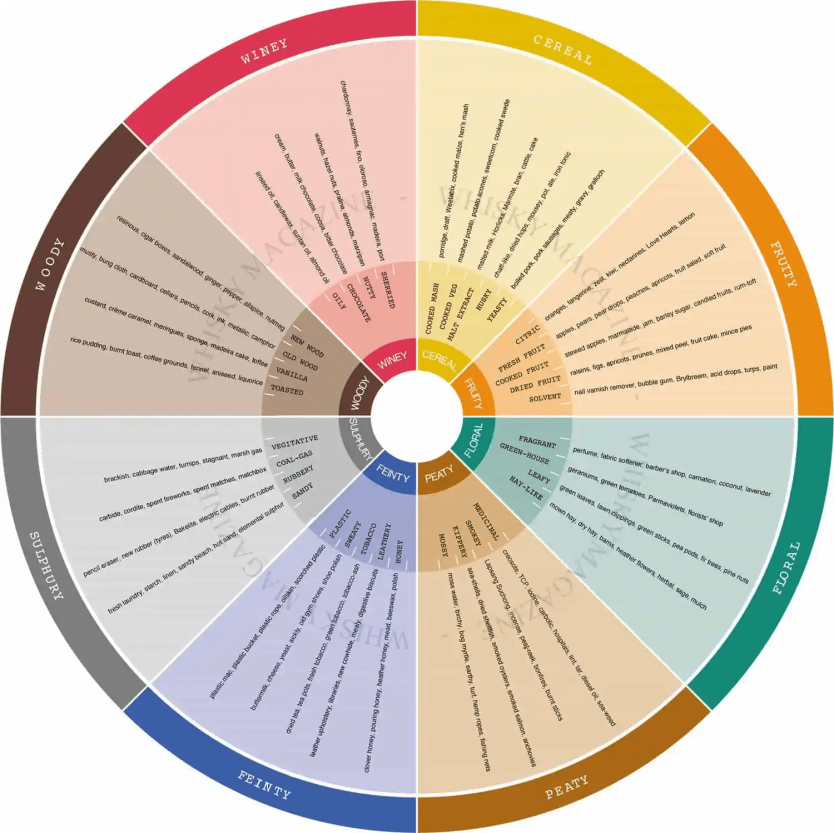
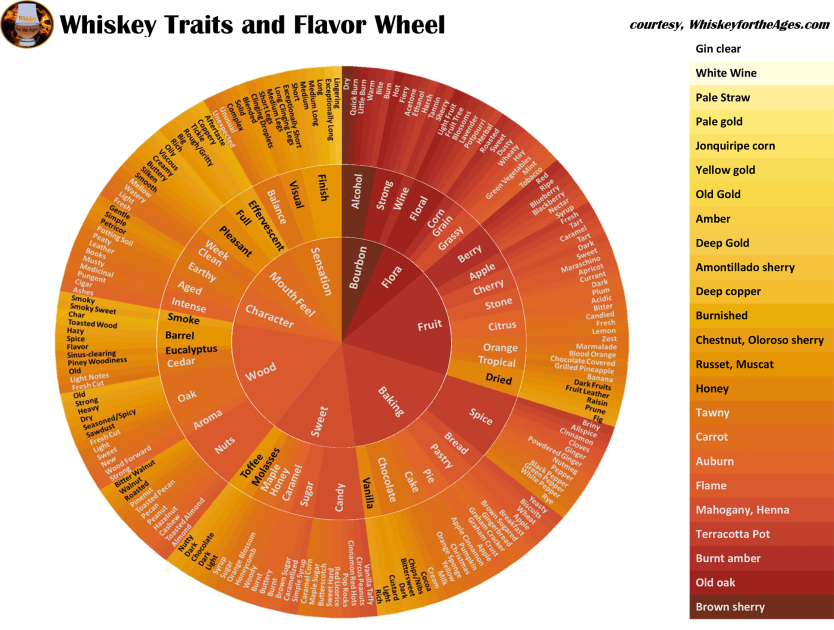
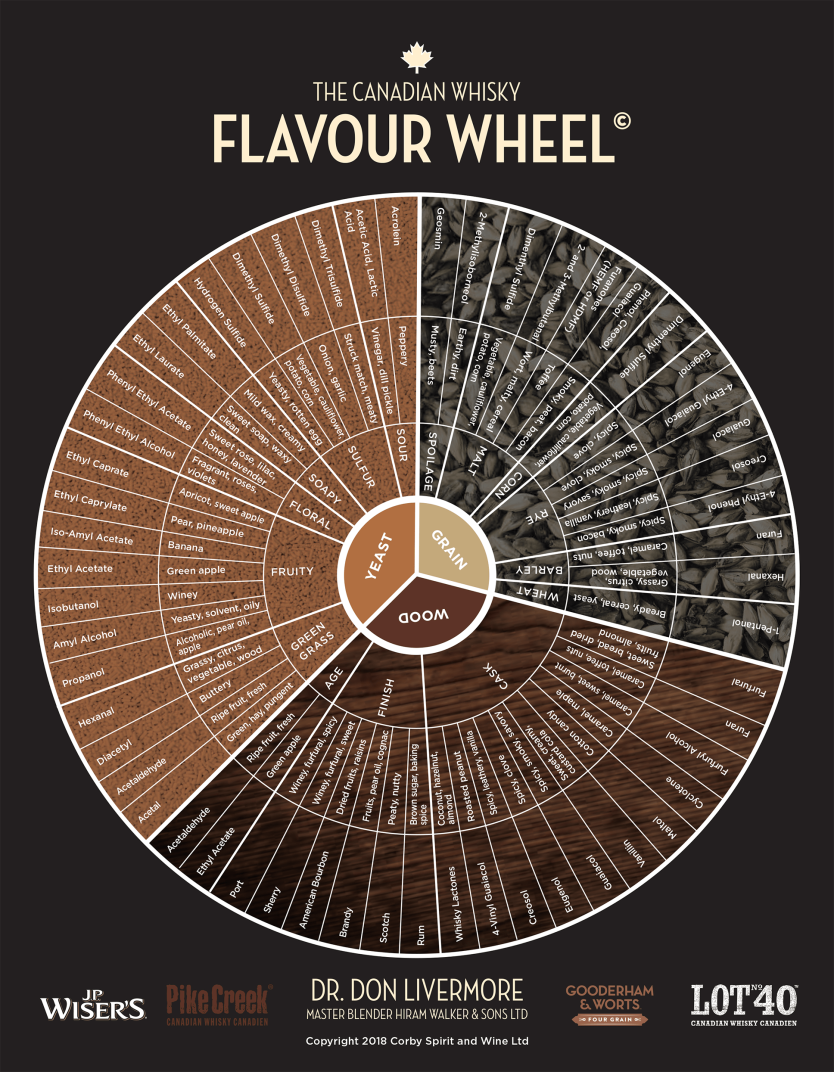

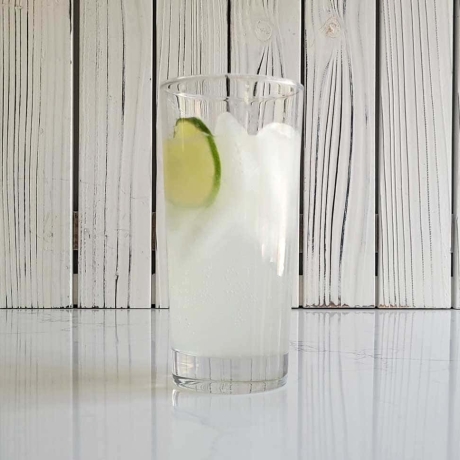
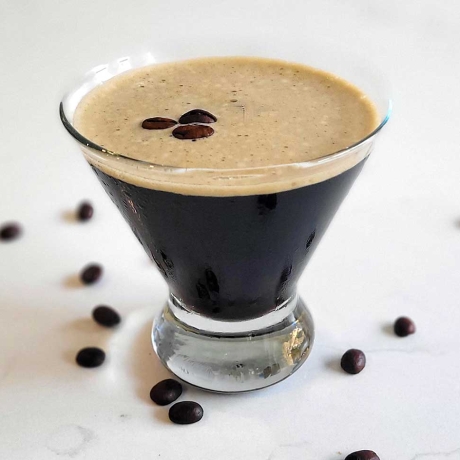


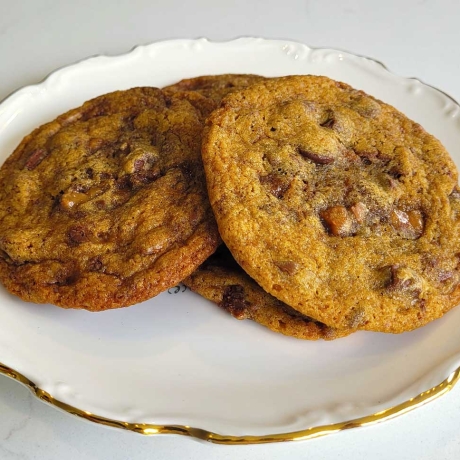

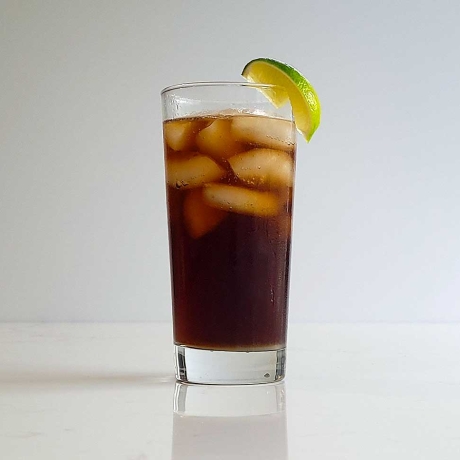
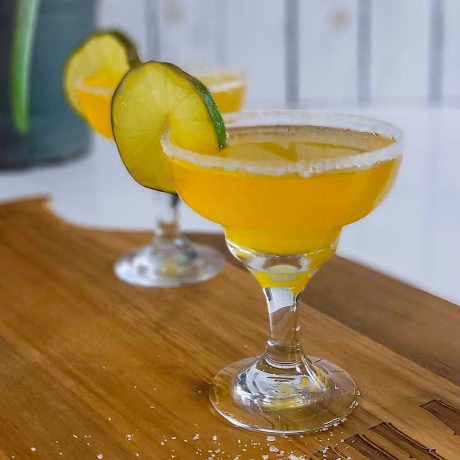
Comments
Be the first to leave a comment.